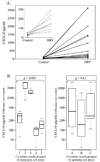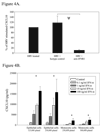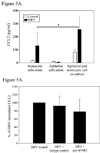Human monocytic cells direct the robust release of CXCL10 by bronchial epithelial cells during rhinovirus infection
- PMID: 20545701
- PMCID: PMC2909328
- DOI: 10.1111/j.1365-2222.2010.03546.x
Human monocytic cells direct the robust release of CXCL10 by bronchial epithelial cells during rhinovirus infection
Abstract
Background: Human rhinovirus (HRV) infections are a major cause of exacerbations in chronic respiratory conditions such as asthma and chronic obstructive pulmonary disease, but HRV-induced immune responses of the lower airway are poorly understood. Earlier work examining cytokine release following HRV infection has focused on epithelial cells because they serve as the principal site of viral replication, and internalization and replication of viral RNA appear necessary for epithelial cell mediator release. However, during HRV infection, only a small proportion of epithelial cells become infected. As HRV-induced cytokine levels in vivo are markedly elevated, this observation suggests that other mechanisms independent of direct viral infection may induce epithelial cell cytokine release.
Objective: Our aim was to test for the importance of interactions between human bronchial epithelial cells (HBECs) and monocytic cells in the control of mediator release during HRV exposure.
Methods: In vitro models of HRV serotype-16 (HRV16) infection of primary HBECs and human monocytic cells, in mono or co-culture, were used. We assessed HRV16-induced CXCL10 and CCL2 protein release via ELISA.
Results: Co-culture of human monocytic and bronchial epithelial cells promoted a synergistic augmentation of CXCL10 and CCL2 protein release following HRV16 challenge. Transfer of conditioned media from HRV16-treated monocytic cells to epithelial cultures induced a robust release of CXCL10 by the epithelial cells. This effect was greatly attenuated by type I IFN receptor blocking antibodies, and could be recapitulated by IFN-alpha addition.
Conclusions: Our data indicate that epithelial CXCL10 release during HRV infection is augmented by a monocytic cell-dependent mechanism involving type I IFN(s). Our findings support a key role for monocytic cells in the amplification of epithelial cell chemokine production during HRV infection, and help to explain how an inflammatory milieu is created in the lower airways even in the absence of extensive viral replication and epithelial infection.
Figures





References
Publication types
MeSH terms
Substances
Grants and funding
LinkOut - more resources
Full Text Sources
Other Literature Sources
Research Materials

